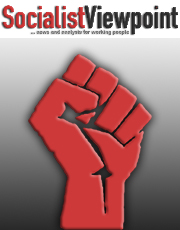Antiwar Unity Required at This Stage
The U.S. antiwar movement is gearing up for a major march on the Pentagon demanding an immediate end to the war against Iraq—a war by now that has completely blown apart Iraqi society, killing hundreds of thousands of civilians and unleashing bitter sectarian and secessionist tendencies.
The March 17 demonstration will take place as the Bush Administration’s latest increase in American troops is reaching its height. Simultaneously, the Pentagon is preparing for a possible attack on Iran. The White House initiated these moves after the antiwar vote in November but the new majority Democratic Congress appears disinclined to take decisive action to end the war.
In addition, the U.S. antiwar movement itself is split, which has weakened the struggle for peace.
The Pentagon protest will be the second in Washington to take place this winter, the first being the 150,000-strong march and rally January 27 organized by the United For Peace and Justice (UFPJ), focusing on influencing the new Congress. Some demonstrators remained in the nation’s capital over the weekend to take part in congressional lobbying.
The political reconfiguration of both legislative chambers as a result of the peace vote is hardly leading to the outcome envisioned by many in the antiwar movement. Some activists report that peace candidates elected in November do not appear inclined to risk going beyond the Democratic Party leadership’s conservative, timid and opportunist approach to the war.
Party leaders oppose cutting off future funding for continuing the war, or initiating impeachment proceedings against one of the most dangerous presidencies in American history, or even passing a binding resolution calling for a swift ending to the unjust, illegal and immoral war.
The march and rally at the Pentagon is being organized by the A.N.S.W.E.R. Coalition (Act Now to Stop War and End Racism), which represents the left wing of the peace movement. Acting together, A.N.S.W.E.R. and UFPJ brought some 300,000 demonstrators to Washington in September 2005, but UFPJ split the movement a few weeks later by publicly declaring it would no longer cooperate with A.N.S.W.E.R., the other nationwide antiwar coalition.
The main reason for the split, beyond the fog of obfuscation, was the matter of orientation toward the Democratic Party, to which UFPJ is close, not that such proximity is necessarily reciprocated by party leaders. A.N.S.W.E.R., which pursues an openly anti-imperialist stance toward President George W. Bush’s “pre-emptive” wars, is far more critical of the Democratic Party’s role in supporting the war and unconvinced it will change.
In addition, A.N.S.W.E.R.’s antiwar rallies always include some criticism of Israel’s oppression of the Palestinian people—a topic that was omitted from UFPJ’s January 27 event, much to the relief of a Democratic Party utterly committed to the status quo in the region, including the Zionist occupation of Palestinian lands after the 1967 war.
A.N.S.W.E.R. brought a half-million people to the January 2003 rally in Washington and over 100,000 to each of a half-dozen other protests in the capital in recent years, but it is difficult to predict the size of the March 17 event. UFPJ has now called for regional protests on March 17 to commemorate the fourth anniversary of the war, as opposed to supporting the Pentagon action. This probably will drain potential participants away from the Washington action. A.N.S.W.E.R. at least supported and promoted the January 27 rally.
The split in the movement occurred just as U.S. public opinion began a dramatic turn away from the war. But while antiwar sentiment put the Democrats back in charge of Congress, its electoral attachment did not result in a significant increase in demonstrations or numbers of protestors in the streets—precisely the factors required to push legislators into taking real action.
In all probability, the Iraq war will continue for years as Bush escalates and Congress equivocates with nonbinding resolutions, delayed and partial “withdrawal” plans and the refusal on the part of the “opposition” party to stand up to the war makers.
The problem with Congress is that its political composition, despite the antiwar vote, is center, center-right, and right, with a weak center-left and no genuine left at all. Congress will act to end the war only in the face of a swiftly impending military defeat combined with ever-growing mass opposition in the streets putting forward demands for immediate withdrawal.
Vibrant peace movements and militant antiwar protests can and do contribute toward ending wars; the Vietnam War proved that. And they can end the Iraq War, and prevent an Iran War as well. But in addition to taking a harder stance on the war, it is necessary for our movement to unite in action. UFPJ has its critique of A.N.S.W.E.R., and A.N.S.W.E.R. has its critique of UFPJ. But both agree on the main political demand, “Bring the U.S. troops home now,” an uncompromising polarity against which all other halfway proposals must be measured.
Differences between these two organizations are not greater than their essential agreement. Our movement—and thus the chances of finally ending U.S. aggression in the Middle East—will be much stronger if UFPJ and A.N.S.W.E.R. worked together in terms of occasional mass actions, and not at cross-purposes.
If UFPJ is not yet ready to join with A.N.S.W.E.R. at the Pentagon March 17, perhaps some of its coalition partners and members of groups within the UFPJ coalition will act in unity in Washington on that day to tell the war makers in the White House, in the Congress and in the headquarters of the war machine itself that they are united in the demand that this horrific war be brought to an end now.


